Everything You Ever Wanted to Know About Traveling With a Dog
Looking for dog travel, Emotional Support Animal, or therapy training info? Here’s the skinny on my world-traveling, therapy-trained ESA, Luna, and the 11 countries we’ve hit so far.
Why did you decide to travel with your dog?
When I decided to travel full-time, leaving Luna behind never even crossed my mind.
For me, getting a dog is a lifelong commitment. She’s my girl, my best friend. And while I have taken business trips without her and left her behind on a few other occasions, I could never re-home her or leave her long term with a friend or parent.
In part, this is because Luna saved my life and continues to help me manage my struggles with depression and anxiety.
In part, this is because she’s my friend and I made a commitment to her when I took her home four years ago.
So even if it means more paperwork, a few places I can’t go because of their quarantine laws, and a slower, altered way of traveling, so be it.

What is an ESA and why does that matter?
An ESA (Emotional Support Animal) is an animal that accompanies a person with an invisible disability like PTSD, panic disorder, or depression. While they are not full-fledged service animals, these dogs (and cats) can significantly improve the health of their owners and, in the US, they are given a couple special benefits. You can find out about the benefits and requirements here. And you can read two ESA owner stories here.
What is therapy training and how has it helped?
In addition to being an ESA, Luna is also therapy trained.
In the US, therapy training is special training given to dogs who will be working in a therapy program. This often means the dogs will visit kids in the hospital, bring joy to those in hospices, work with children with learning disabilities, or otherwise go into an environment where dogs usually wouldn’t be allowed, but a very well-trained dog can bring a lot of joy and do a lot of good.
When I got Luna, she improved my own life so much that I very quickly decided that she could also improve the lives of others. I read everything I could get my hands on about therapy dogs and I trained her according to everything I read.
In a nutshell, therapy training means the dog is comfortable and calm while working. They have to be used to everything, to be mellow, to be able to handle things that normal dogs might not. For example, if a small child in the hospital pulls the dog’s tail, they have to be able to handle it with grace. No biting, nipping, barking, etc. Instead, the dog should just move away. If someone drops a hospital tray, it’s okay for the dog to be startled, but she can’t run off, pee, or start barking like crazy.
When we started to travel, all this training became a godsend. Luna handles flights, airports, bus stations, and new places with grace. In part, I think this is her personality. In part, I think it’s the training, which meant taking her to as many places I could when she was young.
For any traveling pet (ESA or not), I highly recommend therapy training (or Canine Good Citizen training). It’ll make your travels (not to mention everyone who has to travel alongside you) way less stressful.
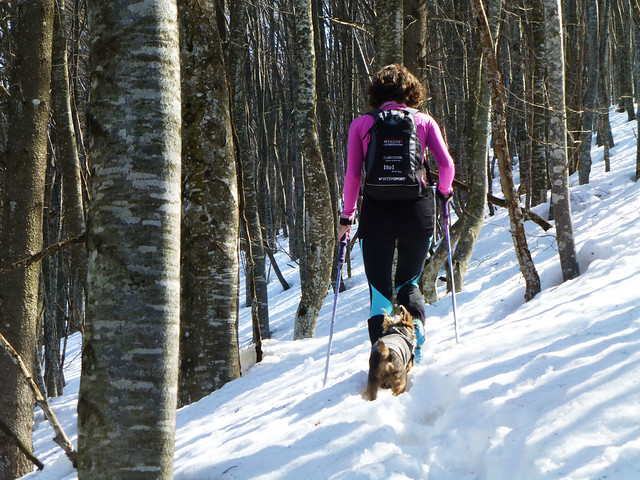
How does she handle flights, particularly long ones?
When I book flights, I do my best to book them in 8-hour chunks or less. This means when flying from Denver to Europe, instead of booking a direct flight, I book through New York or Atlanta and I give myself a very long layover so that I can go outside, let her pee, let her stretch her legs, and give her a little snuggle. This means longer travel days, but it’s worth it to me for her comfort.
Even with that rule, travel days can feel long. Happily, Luna handles them with grace. She loves her carrier and spends her time sleeping for the most part.
What about pee breaks in transit?
Luna can hold it for long stretches, but when we have layovers I either take her outside the airpot or find a pet relief area inside the terminal where possible. She does not pee in flight and I help her manage her bladder by only giving her a little water while we’re traveling (enough to keep her hydrated, but not enough to make her uncomfortable; I do this by giving her ice cubes).
For info about airports with dog relief areas, check out Dog Jaunt.
What about pet food, treats, and other supplies overseas?
Pet supply shops are pretty much the same everywhere we’ve been, though brands vary greatly. Instead of focusing on one brand of pet food, I focus on ingredients when shopping for Luna overseas. Her digestive system seems to be fine as long as I stick with similar ingredients, even if the foods are from a different manufacturer.
In Luna’s case, this means I look for fish and rice (or, if there are absolutely no grain-free fish options, lamb and potatoes) foods and ignore brand names.
Similarly, dog sweaters, leashes, treats, etc. seem to be pretty much the same, just made by different brands.
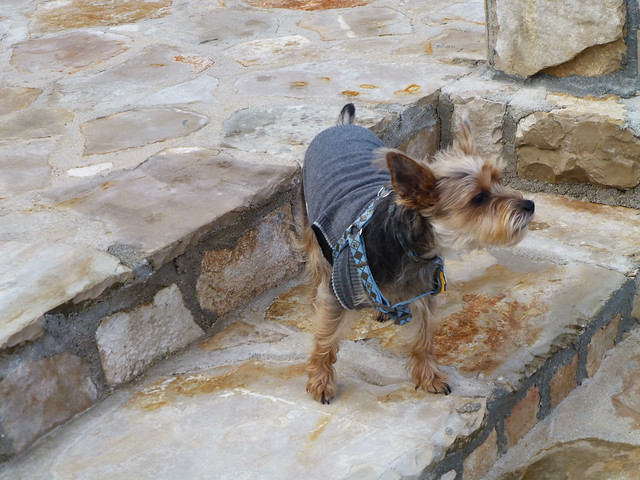
How does she handle being left behind?
When I go to the grocery store, museums, etc., I leave Luna in the apartment/guesthouse/hotel. She’s always been pretty mellow about me leaving her alone and, in part, I think this is because I never made it a big deal. I try to make leaving and going a commonplace thing, not jumping around all excited and giving her lots of snuggles right when I walk back in the door and not acting anxious when I go.
How do you find dog-friendly rentals?
I find a guesthouse, B&B, or apartment where I want to stay (while completely ignoring the dog policies) and then I email the owner to ask if they’ll make an exception for a therapy-trained, non-shedding ESA with references (I have a profile full of Luna references on Couchsurfing.com and another at Airbnb, so landlords can see that she is a champion traveler and unlikely to ruin their home). I find that about 90% of the time, I am granted the exception I ask for (or the place turns out to be pet-friendly).
What’s the protocol with the airlines?
Every airline is different, so you’ll need to check airline sites for their dog policies, fees, and procedures.
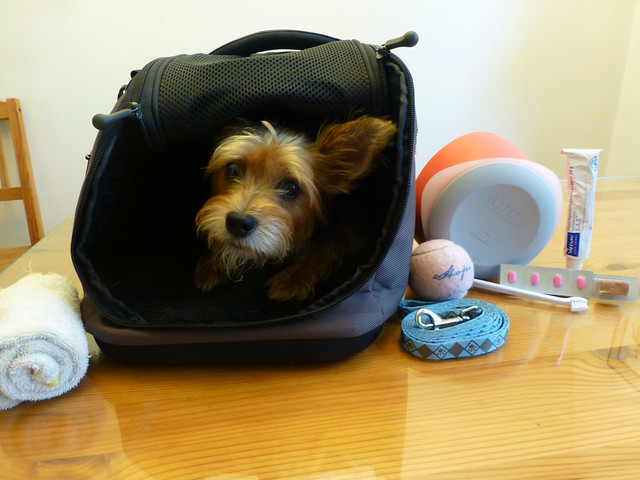
What about paperwork?
Paperwork varies from place to place, but tends to be pretty simple when it comes to going from the US to Europe. For anywhere you travel, in the very simplest terms, you’ll need to have your dog microchipped with an international standard microchip (an easy, out-patient procedure at the vet) and make sure she is up-to-date with her rabies vaccine (in Europe, they recognize it for a year, not three like the US); keep in mind that most places require you to wait at least 21 days after the rabies vaccine/booster before you travel. Then you’ll need a vet to fill out some paperwork within five or ten days or travel (depending where you’re off to).
The UK’s requirements are a little tricky, but the rest of Europe is fairly simple once you get the hang of it.
Is there anywhere you can’t take your dog?
Yep. Australia, New Zealand, and a few other places have super strict quarantines. You can take your dog, but he or she will be in a quarantine facility for at least a few weeks (which is impractical unless you’re going for quite a long time).
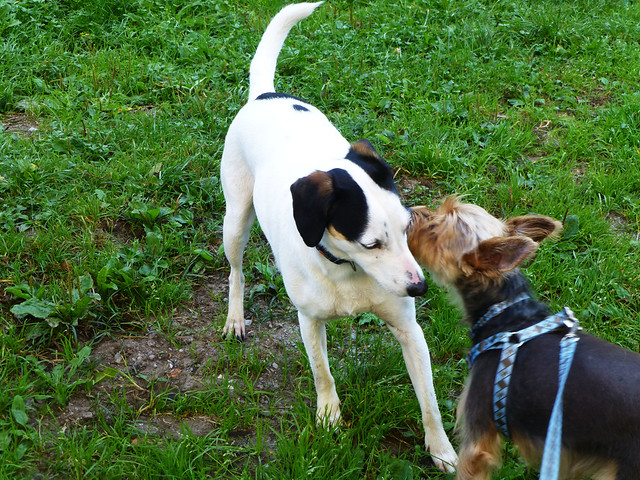
What’s the greatest challenge of traveling with a dog?
It’s not actually that big a challenge usually, but I hate going through customs. I already struggle with anxiety, so the thought that my paperwork might not have a T crossed makes me all kinds of nervous.
Secondarily, vet visits in foreign countries can be a bit stressful. It’s already stressful to have a sick dog, but to explain your dog’s sickness in a mix of Spanish and English and just hope the vet is completely understanding is a whole other can of worms.

What’s the greatest joy of traveling with a dog?
I’m never really alone. I feel like I’m part of the community. I’m forced to get out and explore even when I don’t feel like it. And the locals embrace me with open arms. (I wrote a whole piece on this.)
What about big dogs?
I don’t travel with a big dog myself, but here’s an interview with someone who does.

Where has Luna been?
In addition to the US, Luna has been to Mexico, England, Scotland, Belgium, Germany, Switzerland, France, Spain, Italy, and Croatia.
What’s it like to take a dog to the UK?
The first time we went to the UK (from the US), the process was fairly smooth. Their requirements are a little more complicated than the rest of Europe, but if you follow them to a T, you can bring your dog into the UK with no quarantine. Here’s the breakdown of our experience.
The trickiest part, though? You can’t fly into the UK with a pet in-cabin. (ESAs are allowed, but only on US-based airlines and approved routes). If you can’t bear sending your pet as cargo (I don’t blame you), you can fly into mainland Europe and take a ferry/car to the UK or you can cruise from the US to the UK on the Queen Mary, which has kennels onboard for four-legged passengers.
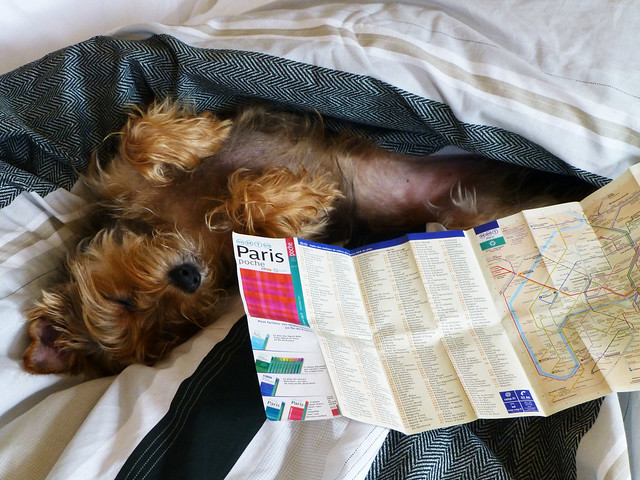
What’s it like to take a dog to Italy?
By far, the biggest country I get questions about is Italy. Here’s the skinny: taking a dog from the US to Italy is very simple (compared to most other places). It’s just a matter of microchip, rabies vaccine, and paperwork. And once you get there, the Italians are likely to just ask if you have your papers and then wave you through.
Once you’re in Italy, I think you’ll be pleasantly surprised. Dogs are welcomed and loved. You can take them in most shops, restaurants, and other public places (unless you see a no-dogs sign on the door). Apartments are often dog-friendly. Trains usually let dogs in carriers ride free. And plenty of locals will want to give your dog treats and snuggles.
You live in Switzerland with Luna now, right? What’s that like?
In February 2014, Luna and I were granted a residence permit in Switzerland’s Bernese Oberland (here’s the skinny on traveling here with a dog). The main difference between our travels in this region and living here now is that we had to register her here in Switzerland twice (the first registration is done through the vet’s office, costs about $50, and takes about three weeks for the paperwork to arrive by mail; the second, which is vitally important if you don’t want a $200 fine, is through the local government office and costs just over $100).
Aside from that, living in Switzerland is just like traveling here. Luna and I love taking the trains for day-trips around the region (and she rides free in her carrier), hiking the Alps as much as possible, and snuggling up at the end of the day in one of several pet-friendly hotels, guesthouses, and rentals in our pretty little valley.
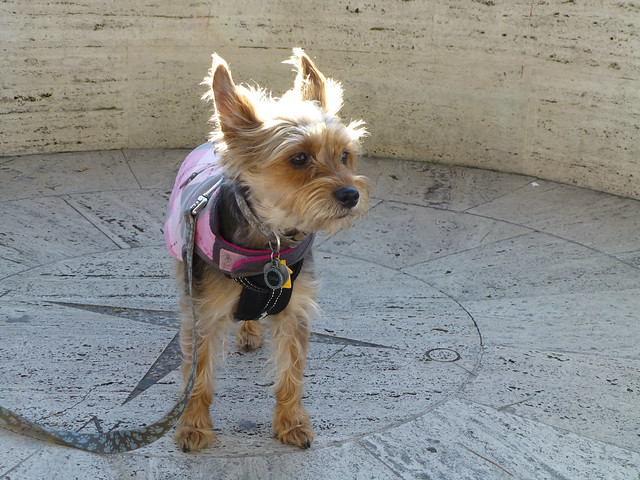
Still have questions?
My friend Mary-Alice wrote a book about dog travel (adorably titled Bone Voyage) and I’m a fan. Also check out Dog Jaunt and Montecristo Travels.
Did this post help you? Share the love by:
:: Buying a copy of my Italy, France, Switzerland, Paris, Barcelona, or Prague guides (already have one? Gift another to a friend!)
:: Clicking here before you make your next Amazon order (it doesn’t matter what you order, if you start by clicking from my site, I’ll get a commission!)
Comments
-
-
Montecristo Travels (Sonja)
Thanks for the round up and mention. I don’t find travel with a dog to be all that difficult either. Like you I am nervous at customs – especially a country I have yet to visit – but that is about it. I find it has been a gift to have to search a little more for accommodation etc. it has allowed us to navigate away from most tourist traps. We get a more honest experience. 🙂
-
-
-
Mary-Alice Pomputius
Thanks so much for the shout-out, Gigi! Hope you and Luna are staying warm in your new home-for-now!
-
hunter
really helpful info. thank you. i’m american citizen living in uk. i have all necessary paperwork from american doctor for ESA. just wondering if you know anyone who has ever traveled to/from the states on UK based airline with an ESA. from my understanding of the Air Carriers Access Act any carrier flying to/from a us destination regardless of where they are based must recognize an ESA but Virgin Atlantic says they won’t for me ( i have miles to use up that’s why i’m asking) rather than flying one of the US carriers.
-
Anne B.
Luna is awesome and looks like she enjoys travelling 🙂 Unfortunately, I can’t imagine my own dog Barney travelling with me. He’s shy (I found him as an abandoned puppy) and he has some mental health disorders (which is bad because there’s almost no place to board him when I need to travel somewhere). I live in Vancouver and I tried to find a good place for him and found some really good tips – maybe they can help someone with similar problems. Although it was hard for me to leave him for few days, I can say I had a good experience with A Dogs Life K9 Centre. As I said, hopefully this could help someone 🙂
-
Anouk Sophia
Thank you Gigi for such an inspirational post on your doggie travels. Really helpful for my planning a 2 month trip around France. Would you be able to advise us on pet carrier? Or what carrier are you using, if it is possible t by on amazon?
Much gratitude,
look forward to reading more of your books x
Anouk Sophia

Angela
Thanks for taking the time to write this. Very informative! I want to travel but have been confused about what to do with my dog (my bestie). This makes me feel confident enough to consider taking her along with me!